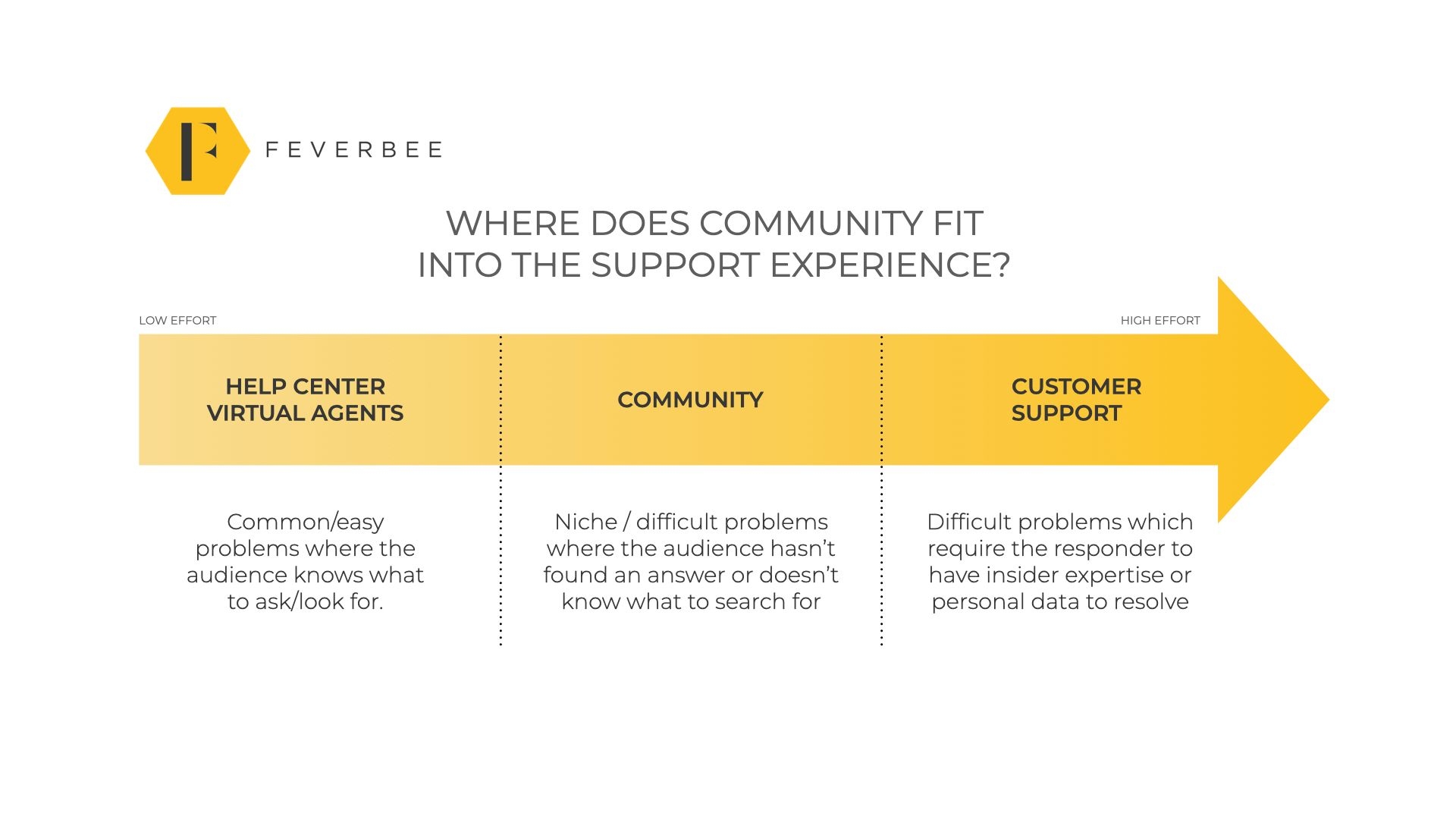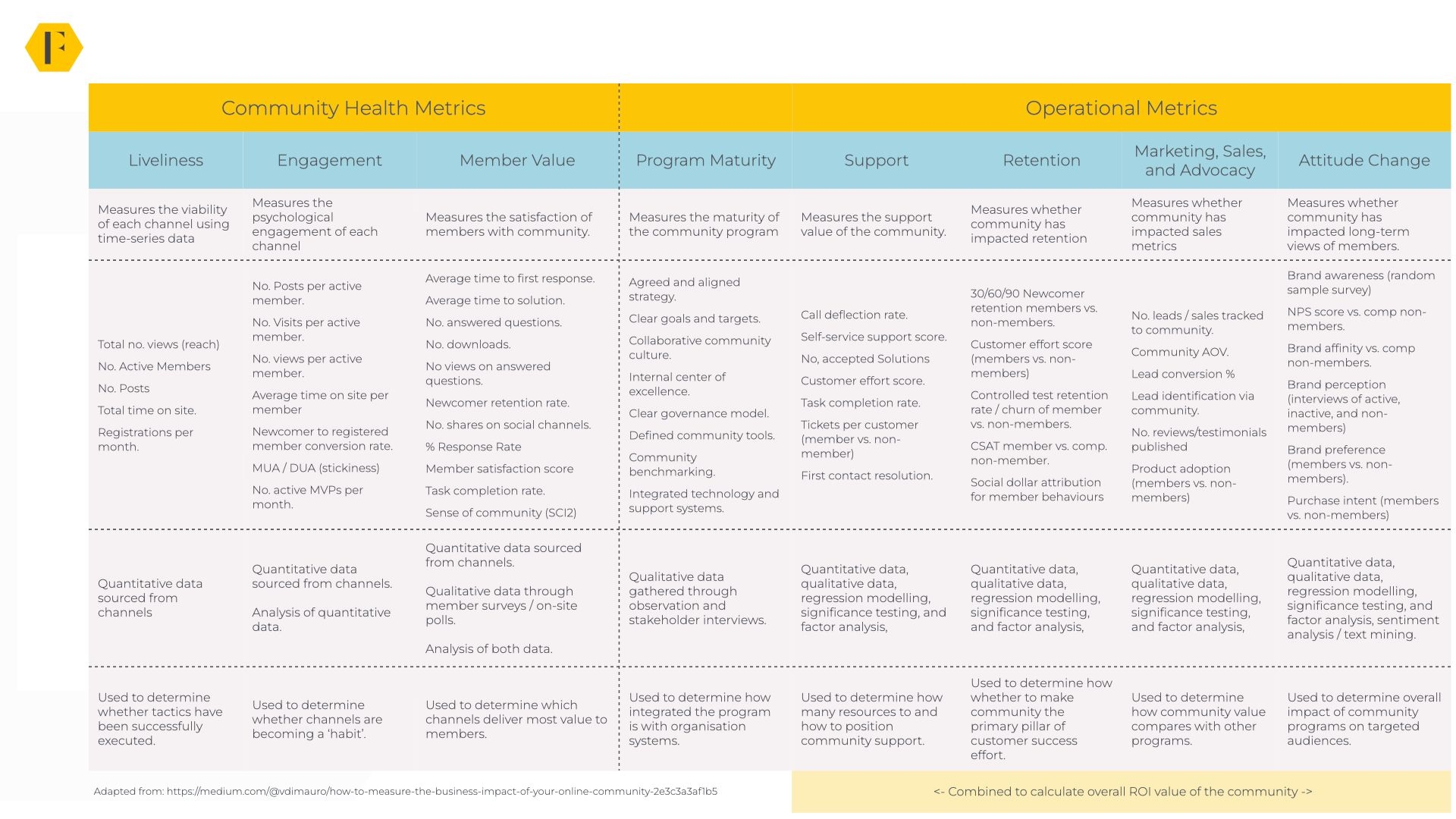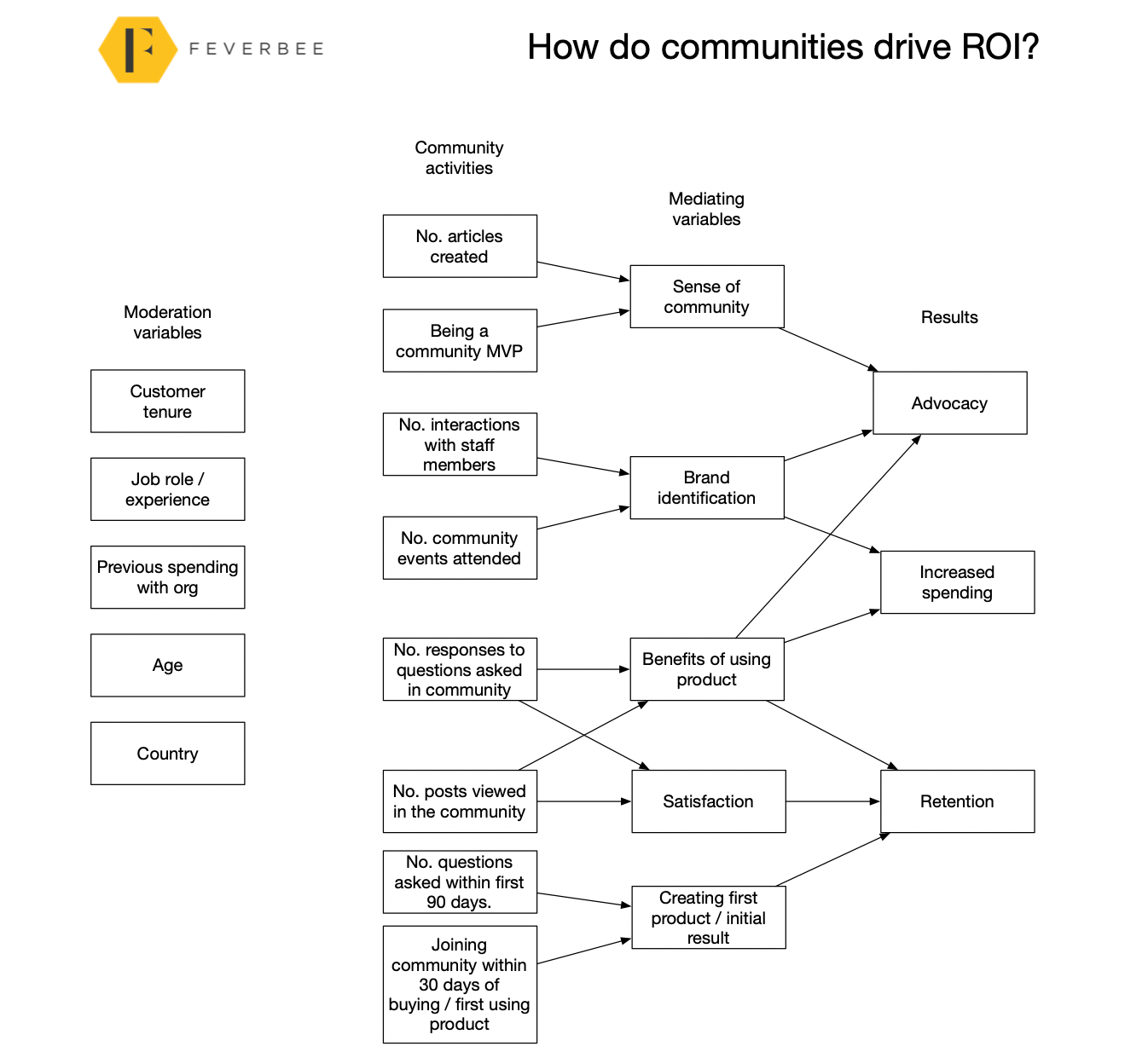A well-managed and fully resourced brand community makes a clear and noticeable impact upon almost every metric C-level executives care about.
- Improves brand preference, affinity, and perception scores
- Increases purchase intent
- Improves customer attitudes such as CSAT and NPS scores
- Increases customer retention
A community also plays a driving role in reducing support costs and acquiring new customers.
Put simply, a community is a remarkably strategic asset, especially for B2B companies.
And, far too often, it’s an asset that is overlooked.
Perhaps the biggest impediment to the widespread adoption of communities is understanding.
If more senior execs knew what community professionals knew, prioritizing community wouldn’t even be a question — it would be the default option.
What is a brand community today?
A brand community is a group of individuals who are connected by a shared interest or passion for a particular brand or product.
When most people think about these communities, their mind usually drifts to one of two things. Either they think of sites like Facebook and Reddit where they engage with friends and others who share a similar interest. Or they think of a traditional community with friendly neighborhoods attending local meetings and helping one another.
Neither is an apt image for understanding communities today.
The brand plays the role of host
Sure there are plenty of brands that use these kinds of tools to engage with their community. But the majority of brand communities today are hosted by the brand. They are places brands have created where their audience can engage with one another.
For members, a community is a fantastic place to find help, connect with peers, learn the latest techniques, and, for some members, build a powerful reputation within the industry.
What makes a community unique?
So, why do you need a community for this? What is it about 'community' that’s unique?
A community creates a unique set of motivational dynamics
It’s not uncommon to find communities where some customers have cumulatively spent years of their lives answering thousands of questions, sharing detailed guides, and mentoring newcomers.
People who otherwise wouldn’t dream of coming home after a hard day at work and doing unpaid customer support on the phone, are happy to do it within a community. That’s because a community creates a unique set of motivational dynamics. It lets people feel helpful, important, and useful.
B2B community is extremely cost-effective
Community is an economical choice for improving the customer experience and benefiting the marketing cycle because it scales better than any other channel.
Each new customer who makes a discovery can share it with another. Any customer who gets an answer to their question can share it with the next person who has that problem.
Better yet, the more people participate in a community, the more they feel a sense of community affinity not just with each other, but with the brand.
The strategic B2B benefits of a brand community
It’s not possible to innumerate every possible benefit of the community. The benefits range from the relatively small (i.e. sourcing testimonials from the community for sales presentations) to the huge (shifting the entire support experience to a community).
However, we can identify the most common benefits. Let's look at two crucial areas:
- Marketing
- Customer support
B2B communities support the entire marketing cycle
Communities provide several specific benefits within the marketing cycle.
These benefits include:
- Growing awareness
- Generating leads
- Improving lead conversation
- Retaining customers

See full image here.
Growing awareness
Communities grow awareness in a variety of (often overlooked) ways. For example, communities attract visitors using long-tail search terms. As more discussions are posted, more members are likely to arrive searching for similar terms.
Communities also help build a thriving mailing list and provide options for pixel-tracking (where you can build segments of visitors to target with social ads). There are also plenty of options to create specific thought leadership communities where you can 'own the term' for your particular niche.
Interest
Communities also help members become more interested in purchasing the product. Members can ask questions about which products to buy and get help from existing customers. Visitors to a community can also see detailed guides created by other members to solve common problems they’re likely to face.
Conversion
Communities are also great at increasing conversion rates. Staff can use community member data to upsell or simply provide the right messaging to the right leads at the right time. If you need the discussion prospects have viewed and the documents they’ve downloaded from the community, you should be able to cater a more appealing offer to them.
Visitors can also see reviews and testimonials created by community members — and a library of authentic user-generated content showing great use cases of the product.
Better yet, simply having a strong community becomes a powerful value-add to the buying proposition. A thriving community is a strong social signal which is impossible to fake.
Retention
Retention is arguably the most popular goal of a community. When people are in a community they get to get high-quality support to get unstuck on any issue they face. They can swap best practices and achieve much more from the product.
Better yet, many will start to feel they’re participating in a group of peers — a group of peers they will lose if they switch to a competitor. This deeper customer engagement increases retention and is all centered around the community.
Advocacy
A community is a natural foundation for advocates to emerge from. You can build personal relationships with a small group of top members. These are the people who will promote you externally, speak at your events, create testimonials, reviews, and case studies for you.
When nurtured carefully, you can build a small army of supporters willing to go to bat for you in any public arena. They also help build a powerful collection of evidence and proof to bring new members and new customers into the community sphere.
Communities are ultimately powerful marketing assets which can support almost every valuable metric. They can reduce customer acquisition costs, increase the share of the wallet, and improve retention rates for the long term.
Customer support benefits of a B2B brand community
Community provides support that goes beyond the offerings of a typical customer service team. Let’s look at few:
- Supporting different customers
- Solving the ‘in-between’ problems
- Increasing confidence
- Creating a feedback mechanism
Supporting specific types of customers
One major benefit of a community is it provides customers with an incredible 'self-support' option. A new generation of customers has emerged over the past decade who are far less likely to pick up the phone and contact a customer support agent. They have a greater desire to do it themselves.
Providing great documentation, tutorials, and chatbots can certainly help. But none of these can provide the depth and range of responses as a community. If a customer doesn’t know what terms to search for or how best to describe their solution, a community can help.
A community is also frequently used to support customers who haven’t paid for a premium level of support or are perhaps out of warranty or maybe are simply at the lower end of the ARPU continuum. It doesn’t make sense to provide $70 of value in support calls to customers paying $50 per year. But the marginal cost of resolving a question is essentially zero. Better yet, the more questions are answered in the community, the more future customers searching for a solution are likely to find it.
Solving the 'in-between' problems
Common and easy issues can be resolved with documentation and tutorials. Likewise, questions that require the customer to share private data or are especially challenging need a support agent to help. But between these two are what we call the in-between issues.

See full image here.
These are the innumerable number of issues where the community can be the first place for customers to go to get unstuck on any issue. They are precisely the kinds of questions other customers have the knowledge to help resolve.
Increasing confidence
Even the worst 'issue' is too narrow. A community is a great place for people to get a 'gut check' or see if they’re following the right approach to achieving their goals. It’s a place where members can share their approach and get feedback from others. There simply isn’t any other place people can go for these kinds of questions.
By being able to get feedback from other customers as they progress, a customer can feel more confident that they're doing the right thing and achieving the right outcome.
If the product you sell is especially complex, then a community is essential for members to have a group of peers they can turn to check that they’re following best practices and benefiting from the collective wisdom of the community.
Creating a feedback mechanism
A community also serves as an ever-present feedback mechanism. This shows up in multiple ways. For example, when members highlight problems in a community, this information can be escalated to product managers or others who can resolve it. Better yet, if members are struggling with implementing a product, they might be highlighting ways the documentation or customer onboarding processes could be improved.
Even seeing which discussions members most frequently visit or participate in offers interesting insights that could be of use in the future.
Some communities take this even further and have an ideation section in which members can proactively suggest improvements and vote on them. The most popular requests naturally rise to the top.
Ignore B2B community at your own peril
Alas, far too frequently, community is seen as a luxury. A luxury that is last in line for additional resources in good times and first in line for cutbacks in bad times. Many organizations don’t even attempt to build a community at all.
By not investing in community, an organization misses an incredibly valuable channel that helps support its marketing strategy and the entire marketing lifecycle, from growing awareness and generating leads to improving lead conversation and retaining customers.
Customer experience
Instead of each new customer having thousands of peers to ask questions and get support from, they instead rely upon outdated support channels and whatever documentation is available.
Customer insights
Worse yet, not investing in community also results in a staggering amount of expertise going to waste. Customers who are utilizing products in innovative ways or have a great case study to share often find themselves without an obvious place to share it.
Organizations commonly worry about losing tacit knowledge when employees leave a company. And that’s just one person leaving one company. Now consider the missed opportunity when customers who have accumulated years of hands-on experience using your products depart without ever sharing their best advice.
How to measure success for a B2B community
There are plenty of methods to measure the ROI of online communities.
The reality, however, is few organizations take a purist view of measuring the ROI of a community (i.e. the % return for every dollar spent). Similar to PR, branding, and most other activities, the majority instead try to determine the impact of their community on operational metrics they do care about.
The table below highlights the most common impacts and the kind of measures which are typically used.

See full image here.
Community impact metrics
We segment these into metrics that evaluate the health of a community and those which evaluate the value of the community.
Health metrics
Health metrics are those which show whether you have a vibrant, active, community. The key metrics here include those which show:
- Liveliness (i.e. the quantity of engagement)
- Member interest (i.e. how engaged are members when they do visit)
- Value members are getting from the community
If you don’t perform well in these metrics, not much else matters.
Community value metrics
The next set of metrics is at the operational level. These are the metrics people outside of the community care about. These typically show up in:
- Support (providing improved support to customers).
- Retention (reducing churn, encouraging members to stay for longer).
- Marketing and sales (generating valuable material, generating leads, and improving product adoption).
- Product (generating useful insights and feedback to improve the product).
But perhaps the most powerful metrics are those which reflect attitude change.
If we look at an example of how a community might impact results we care about, the mediating variables are almost always a change in attitudes.

See full image here.
A community is a powerful tool for changing attitudes towards your brand. Specifically, it can impact
- NPS / CSAT scores (by delivering improved performance).
- Brand affinity and brand perception (by creating a more positive feeling towards the brand).
- Brand preference vs. competitors (by situating members amongst a group of peers who prefer the brand).
If you're looking for a tool to help you measure impact as you manage and engage with your community members across multiple channels, check out the guide to evaluating community growth platforms.
How much should a B2B community cost?
This is a little like asking how much a marketing campaign should cost.
There isn’t an exact answer. But there are broad ranges to work with depending upon ambition, risk tolerance, and where the point of diminishing returns kicks in. Up to the point of diminishing returns, the more you spend, the better the results. Spend too little, however, and you’re not going to see much impact.
Community isn’t any different.
Some organizations launch a small Facebook group on a shoestring budget and see what happens. Others hire a community team and use an enterprise community platform and grow from there.
Despite the ranges and differences in approaches, we can outline some broad costs for developing a community.

See full image here.
Brian Oblinger shares a terrific example budget here.
Summary
Communities are a little like nuclear power plants. They take some time to set up, but they generate an incredible amount of energy through self-sustaining interactions which power up almost every part of the customer experience.
By understanding the real value of online communities, organizations can embed them into their marketing and customer experience strategies to deliver better products and services for stronger business outcomes. This can be particularly powerful for B2B online communities.
Communities attract newcomers to a brand and increase retention of the members you already have. They provide a better support experience and increase the success rate of customers. Ultimately, communities are one of the most powerful strategies to attract, satisfy, and retain customers today.
Make community your strategic advantage with Common Room
Get started for free or request a demo to see the platform in action.
For more community building tips, join the Uncommon Community.
Looking for consultancy support? FeverBee will help you build a better community for your customers.
